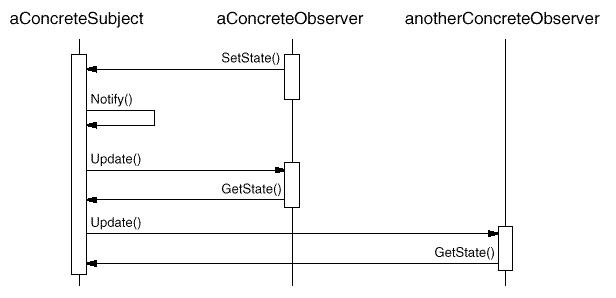Applied Design Patterns with Java
Behavioral :: Observer (293) {C ch 22}
Collaborations
- ConcreteSubject notifies its Observers whenever a change occurs that could make its Observers'
state inconsistent with its own.
- After being informed of a change in the concrete Subject, a ConcreteObserver object may
query the subject for information. ConcreteObserver uses this information to reconcile its state with that of the Subject.
- The following interaction diagram illustrates the collaborations between
a Subject
and two Observers:

Note how the Observer object that initiates the change request postpones its update until
it gets a notification from the Subject. Notify is not always called by the Subject. It can be called
by an Observer or by another kind of object entirely.
Consequences
The Observer pattern allows varying subjects and observers independently. Subjects
can be reused without reusing their Observers, and vice versa. It allows adding Observers without modifying
the Subject or other Observers.
Observer has the following benefits and liabilities:
- Abstract coupling between Subject and Observer.
All a Subject knows is that it has a list of Observers, each conforming
to the simple interface of the abstract Observer class. The Subject doesn't know the concrete class of any Observer.
Thus the coupling between Subjects and Observers is abstract and minimal. Because Subject and Observer
aren't tightly coupled, they can belong to different layers of abstraction in a system. A lower-level subject can
communicate and inform a higher-level Observer, thereby keeping the system's layering intact. If Subject
and Observer are lumped together, then the resulting object must either span two layers (and violate
the layering), or it must be forced to live in one layer or the other (which might compromise the layering abstraction).
- Support for broadcast communication. Unlike an ordinary request, the notification that a Subject sends
needn't specify its receiver. The notification is broadcast automatically to all interested objects that subscribed
to it. The Subject doesn't care how many interested objects exist; its only responsibility is to notify its
Observers. This gives the freedom to add and remove Observers at any time. It's up to the Observer to handle or ignore
a notification.
- Unexpected updates. Because Observers have no knowledge of each other's presence, they can be blind
to the ultimate cost of changing the Subject. A seemingly innocuous operation on the Subject may
cause a cascade of updates to Observers and their dependent objects. Moreover, dependency criteria that
aren't well-defined or maintained usually lead to spurious updates, which can be hard to track down. This problem
is aggravated by the fact that the simple update protocol provides no details on what changed in the Subject.
Without additional protocol to help Observers discover what changed, they may be forced to work hard to deduce
the changes.
Catalog Behavioral Prev Next

